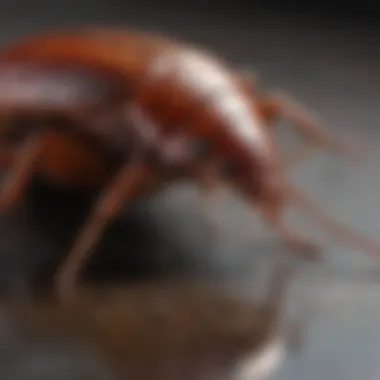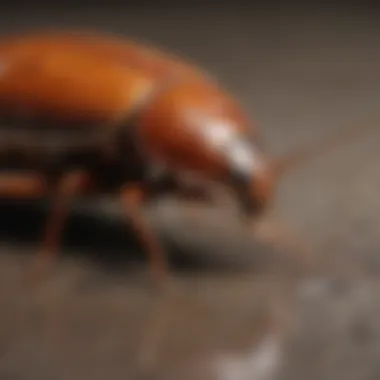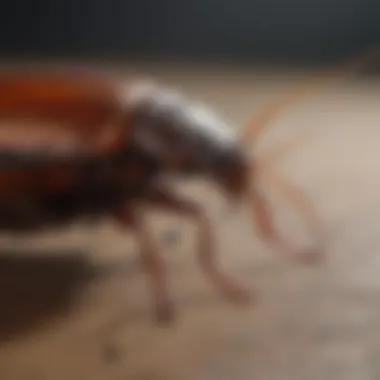Understanding Cockroach Infestations: Causes & Solutions


Intro
Cockroaches are often viewed as one of the more unwelcome guests in any home. Their presence can evoke feelings of disgust and concern about hygiene. While it may be easy to dismiss them as mere pests, understanding the underlying reasons for their existence in our living spaces is crucial. This article offers insights into why cockroaches thrive in certain environments and provides a comprehensive overview of prevention and control methods.
Understanding the presence of cockroaches involves analyzing various factors, from biological characteristics to environmental conditions. This not only assists homeowners in dealing with current infestations but also aids in avoiding future issues. Effective pest management strategies are essential, encompassing both natural and chemical methods, tailored to fit different preferences and situations. Let's explore the fascinating yet unsettling world of cockroaches to arm ourselves with the necessary knowledge to combat these resilient creatures.
Prologue to Cockroach Infestations
Cockroach infestations represent not only a nuisance but also a concern for health and hygiene in residential environments. Understanding this issue is paramount for homeowners and housewives alike. As resilient creatures, cockroaches can rapidly multiply and spread, making the task of addressing an infestation more complicated as time progresses. This section aims to equip readers with the knowledge required to recognize the signs of cockroach presence and understand the broader implications of having these pests in their homes.
Overview of Cockroaches
Cockroaches are among the most common pests found in households. There are many species, including the German cockroach, the American cockroach, and the Oriental cockroach, each with distinct characteristics and habitat preferences.
These insects are generally brown to black with a flat body. They can fit through small cracks and crevices, which makes them particularly adept at infiltrating homes. Most cockroaches are nocturnal and prefer dark, warm places, which makes kitchens and bathrooms prime areas for their activity. They are scavengers, feeding on a variety of organic matter, commonly found in residues and hidden spots in the home.
Why They Matter
Understanding the presence of cockroaches is essential for several reasons. First, they can pose health risks due to their ability to transmit diseases. They may carry pathogens that can contaminate food and surfaces, leading to gastrointestinal illnesses and other serious health conditions.
Second, their presence can indicate larger problems within the home environment, such as poor sanitation or structural issues allowing entry points. Finally, knowing how to identify and deal with these pests effectively can save homeowners significant time, effort, and financial resources in the long run.
"It's not just about eliminating cockroaches; it's about understanding why they chose your home to inhabit."
Through this article, readers will learn the biological aspects, environmental factors, and effective control methods tied to these pests, empowering them to take proactive measures against potential infestations.
Biological Insights into Cockroaches
Understanding the biological insights into cockroaches is critical for any effective pest management strategy. This section highlights key aspects such as species identification, the life cycle of these insects, and their feeding habits. Each part contributes to a more complete understanding of how cockroaches operate within their environments, which is essential for homeowners looking to address infestations effectively.
Species Identification
Cockroaches comprise numerous species, but only a few are common pests in residential areas. The American cockroach, the German cockroach, and the Oriental cockroach rank among the most frequently encountered species. Each species holds distinct traits and behaviors, making identification essential.
- American cockroach: Known for its reddish-brown color and large wings, this species prefers warm, moist conditions. They are often found in basements or around drains.
- German cockroach: Smaller than its American counterpart, the German cockroach is light brown with two distinctive stripes running down its back. It is notorious for its rapid reproductive rate, often establishing significant colonies in kitchens and bathrooms.
- Oriental cockroach: Characterized by its dark color and lack of wings, the Oriental cockroach thrives in cooler environments and is commonly found in basements or near garbage.
Proper identification enables targeted control measures. For instance, targeting the breeding sites of a German cockroach is crucial, as they reproduce quickly.
Life Cycle of Cockroaches
The life cycle of cockroaches consists of three main stages: egg, nymph, and adult. Understanding these stages is important for managing infestations effectively.
- Egg stage: The female cockroach carries an egg case, known as an ootheca, which contains multiple eggs. Depending on the species, the ootheca may be laid in hidden areas, making these eggs hard to detect.
- Nymph stage: Once hatched, nymphs resemble miniature adults but lack wings and mature over several months. They are vulnerable to environmental factors and typically remain hidden in dark places during this stage.
- Adult stage: After several molts, nymphs develop into adults. Adult cockroaches have full wings and can reproduce rapidly, further complicating control efforts. A female German cockroach can produce an average of 30 to 40 eggs at a time, leading to exponential population growth.
Awareness of these stages helps homeowners time their interventions more effectively, focusing on preventative measures at various life cycle points.
Feeding Habits
Cockroaches are omnivorous scavengers, known for their diverse diet. Their feeding habits significantly influence their attraction to homes. Common food sources include:
- Starches: Such as bread, cereal, and other processed foods.
- Sugars: Cockroaches are drawn to sweet substances including fruit and candy.
- Grease and fats: Found in leftover food and spills often left unattended.
Attraction to food sources often results from improper food storage and cleanliness. Being aware of their feeding habits can encourage better sanitation practices. Regularly cleaning food spills and ensuring food items are stored in sealed containers can significantly reduce the likelihood of infestation.


"Effective management of cockroach infestations requires a thorough understanding of their biological characteristics. Knowing the species, life cycle, and feeding habits enables targeted preventative and control strategies."
Environmental Factors Contributing to Infestations
Understanding the environmental factors that contribute to cockroach infestations is crucial. This topic addresses the settings that create conducive environments for these pests. Recognizing these factors empowers housewives and homeowners to identify and mitigate risks. It also highlights the synergy between environmental conditions and cockroach behavior.
Common Hiding Spots
Cockroaches often seek shelter in places that provide safety and minimal disturbance. Common hiding spots include:
- Behind appliances: Areas behind refrigerators, ovens, and microwaves are preferable as they provide warmth and moisture.
- Cracks and crevices: Small gaps within walls, floors, and cabinets serve as ideal hiding locations.
- Basements: This damp and dark area often becomes a sanctuary for cockroaches.
- Pantry: Stored food supplies can attract them while they hide among containers.
Addressing these hiding spots is vital. Sealing gaps and regularly cleaning these areas can significantly reduce cockroach presence.
Moisture Levels and Their Impact
Moisture is an essential factor affecting cockroach activity and reproduction. Cockroaches thrive in humid environments. Ideal conditions often arise in kitchens and bathrooms, where water sources are abundant.
- Leaks: Tap leaks and plumbing issues create favorable moisture levels for cockroaches.
- Humidity: High indoor humidity encourages breeding. Regularly monitoring moisture control can be effective in diminishing infestations.
Proactively addressing moisture problems can disrupt cockroach life cycles. Maintaining low humidity levels is essential for effective prevention.
Food Sources That Attract Cockroaches
Cockroaches are opportunistic feeders. They will consume a wide variety of food items. However, certain sources are particularly enticing:
- Leftover food: Crumbs and spills create an inviting buffet for cockroaches.
- Unsealed containers: Food stored in open or improperly sealed containers can be easily accessed.
- Pet food: Leaving pet food out overnight becomes a target for cockroaches.
To lessen attraction, maintaining a clean kitchen is crucial. Regularly cleaning surfaces, sealing containers, and properly storing food can significantly decrease cockroach draw.
"Prevention is far more effective than treatment when it comes to managing cockroach populations."
Taking control of these environmental factors can lead to significant improvements in managing cockroach presence. By understanding their hiding preferences, moisture needs, and food sources, homeowners can create an inhospitable environment for these pests.
Behavioral Aspects of Cockroaches
Cockroaches exhibit a range of behaviors that are pivotal to their survival and propagation. Understanding these behaviors is crucial for homeowners and pest control professionals alike. It provides insight into why infestations occur and how they can be effectively managed. Two significant aspects of cockroach behavior are their nocturnal activity patterns and reproductive habits. By comprehending these elements, one can develop targeted strategies for prevention and control.
Nocturnal Activity Patterns
Cockroaches are primarily nocturnal creatures, which means they are most active during the night. This behavior serves several purposes. First, being active at night helps them avoid predators and minimizes exposure to humans. Their keen sense of smell and ability to navigate in darkness allows them to seek food and shelter more effectively.
During nighttime, cockroaches engage in foraging behaviors, searching for organic matter that can serve as food. This is also the time when they are likely to explore new environments, including homes and kitchens. The absence of light decreases the risk of detection, allowing them to move around more freely.
This nocturnal activity can exacerbate infestations. Homeowners might not notice the signs of an infestation until it's significantly advanced. Recognizing this behavior can aid in setting traps or implementing other control measures during these peak hours.
"Understanding the nocturnal habits of cockroaches enables more strategic pest control planning."
Reproductive Behaviors
In terms of reproduction, cockroaches exhibit fascinating and efficient behaviors. They have a rapid reproductive cycle, which significantly contributes to their notorious status as pests. A single female German cockroach can produce up to 40 offspring at a time, and they can reproduce multiple times a year. This high reproductive rate ensures that populations can grow rapidly.
Female cockroaches may lay their egg cases in dark, secluded areas, which are typically close to food sources—this behavior enhances the survival of the eggs and, eventually, the nymphs. The egg cases, known as oothecae, are often dropped in places where they remain hidden from potential threats. This secretive reproductive strategy means that if one finds even a few cockroaches, many more could be lurking nearby, undetected.


Cockroaches and Human Interaction
Understanding the relationship between cockroaches and humans is crucial in managing infestations. Cockroaches are not just nuisances; they can pose significant health risks and influence the psychological well-being of those living in infested environments. Therefore, recognizing the consequences of their presence aids in creating effective control strategies and preventive measures.
Health Risks Associated with Infestations
Cockroaches are vectors for various pathogens, making their presence in homes a serious health concern. They can carry bacteria, viruses, and parasites which may lead to health issues ranging from mild allergies to serious illnesses. The most commonly associated health risks include:
- Asthma and Allergies: Cockroach droppings, saliva, and body parts contain allergens that can trigger asthma attacks and allergic reactions, especially in children.
- Food Contamination: They often invade kitchens and food storage areas, contaminating food sources. This can result in gastrointestinal illnesses due to pathogens like Salmonella and E. coli.
- Vector for Disease: Cockroaches can transport pathogens on their bodies from unsanitary areas, potentially exposing humans to diseases.
To mitigate these health risks, awareness becomes vital. Homeowners should keep surfaces clean, maintain food storage hygiene, and eliminate potential nesting sites. Efforts should also include addressing moisture and debris to minimize attraction.
Psychological Effects of Cockroach Presence
The psychological impact of cockroaches should not be overlooked. An infestation can result in heightened stress and discomfort, affecting quality of life. Having cockroaches in one’s home can lead to:
- Anxiety and Fear: The mere sight of a cockroach may trigger anxiety. For some, it becomes a persistent worry, impacting daily activities and peace of mind.
- Sense of Uncleanliness: Cockroaches are often associated with filth and unsanitary conditions. Their presence can lead individuals to feel ashamed about their living environment.
- Social Stigma: People may fear judgment from visitors or friends regarding their pest problem. This could lead to social isolation if open discussion about the issue is avoided.
It is important to recognize that the presence of cockroaches goes beyond just a physical nuisance; it can have profound implications for overall mental and emotional well-being.
Effective Pest Control Methods
Cockroaches are resilient pests that can quickly infest homes if not managed properly. Understanding effective pest control methods is crucial to mitigate their presence. This section will discuss various strategies for dealing with cockroaches, highlighting the benefits and considerations of each method. It will cover chemical control options, natural solutions, and professional services.
Chemical Control Options
Chemical control has been one of the most commonly used methods for addressing cockroach problems. Insecticides specifically formulated for cockroaches can be effective in killing them quickly. These products usually come in the form of sprays, baits, or powders.
Some benefits of using chemical control options include:
- Rapid Results: Many chemical treatments offer fast action, which can eliminate visible infestations promptly.
- Targeted Application: When applied correctly, these products can be focused on known hideouts and entry points, increasing their effectiveness.
However, there are some important considerations:
- Health Risks: Chemicals can pose health risks to children, pets, and even adults if not used properly. Always read labels and follow guidelines.
- Resistance Development: Over time, cockroaches may develop resistance to certain chemicals, necessitating the use of different products or strategies.
Natural and Eco-Friendly Solutions
Natural pest control solutions are gaining attention due to their low toxicity and environmental friendliness. Many homeowners prefer these methods as they are safer for children and pets.
Some effective natural options include:
- Boric Acid: This compound is a common ingredient in many natural roach baits. It disrupts cockroaches' digestive systems and is effective over time.
- Diatomaceous Earth: This fine powder is a natural insecticide that damages the exoskeleton of cockroaches, leading to dehydration.
- Essential Oils: Certain oils, like peppermint and tea tree oil, can deter cockroaches with their strong scents.
The main advantages of using these methods are:
- Safety: Natural solutions are generally safer for households.
- Sustainability: They do not contribute to chemical pollution or pest resistance.
One drawback to note is that natural solutions may require more time to show results compared to chemical options.
Professional Pest Control Services


Engaging professional pest control services can be highly effective, especially for extensive infestations. These services often offer a comprehensive approach that combines different methods tailored to the specific situation.
The benefits of opting for professional services include:
- Expertise: Professionals have training and experience in identifying and treating cockroach infestations effectively.
- Long-Term Solutions: They can provide guidance on prevention and maintenance to reduce the risk of future infestations.
- Customized Treatments: Each situation is different; professionals can recommend the best course of action based on the severity of the infestation and the structure of your home.
However, it is essential to consider the costs associated with professional services. They can be higher than purchasing home treatments, but the investment may be worthwhile in achieving a cockroach-free environment.
Effective pest control is a combination of proper techniques, understanding cockroach behavior, and proactive measures to prevent future infestations. Choosing the right method depends on the level of the infestation and individual preferences regarding safety and environment.
By understanding these pest control methods, homeowners can make informed decisions about how to combat cockroach infestations effectively. Careful consideration of each option, its benefits, and potential downsides is vital for successful management.
Preventive Measures to Avoid Infestations
Preventive measures are crucial for reducing the likelihood of cockroach infestations in homes. Understanding how to take proactive steps can save time, money, and stress that come with dealing with these pests. By fostering a clean and unwelcoming environment for cockroaches, homeowners minimize the risk of attracting these resilient insects.
Best Practices for Keeping Homes Clean
Consistency in cleanliness is vital. Cockroaches are attracted to food particles, grease, and any form of organic matter. Following specific practices can help maintain a cockroach-free environment.
- Regular Cleaning Routine: Establish a daily cleaning routine that includes sweeping and mopping floors, wiping down kitchen surfaces, and sanitizing areas where foods are prepared.
- Waste Management: Ensure garbage bins are sealed tightly and emptied regularly. Leftover food or moldy items attract cockroaches and serve as a breeding ground.
- Tidy Up: Keep food stored in airtight containers. This simple step prevents accessibility for cockroaches and other pests.
Maintaining a high standard of cleanliness serves as the first line of defense against cockroach infestations.
Sealing Entry Points
Another integral preventive measure is the sealing of potential entry points. Cockroaches can enter your home through small cracks and crevices. Ensuring these entry points are secured can greatly reduce the risk of an infestation.
- Inspect Doors and Windows: Check for gaps around doors and windows. Install weather stripping or door sweeps if necessary.
- Fill Cracks and Holes: Use caulk to fill in cracks and holes in walls, baseboards, and around pipes. This helps avoid cockroaches entering from the outside.
- Ventilation Grills: Ensure that any ventilation grills are fitted tightly and have mesh screens.
Taking these measures limits the avenues available for cockroaches to invade your home.
Regular Inspections and Maintenance
Conducting regular inspections and maintenance is essential for long-term prevention. Homeowners should routinely check for signs of cockroaches and address any potential issues immediately.
- Routine Checks: Set a schedule for inspecting areas prone to infestion, such as basements, kitchens, and bathrooms. Look for droppings and egg cases as indicators of a problem.
- Fix Leaks Promptly: Address leaks and moisture issues. Cockroaches thrive in damp environments. Keeping areas dry discourages their habitation.
- Professional Inspections: Consider hiring pest control professionals for periodic inspections. These experts can identify hidden problems and recommend effective treatments.
Regularity in inspections allows homeowners to catch problems early and manage them proactively.
End
The conclusion section is vital to encapsulate the insights presented in this article regarding cockroach infestations. Recognizing the significance of this topic is essential for housewives and homeowners alike. Understanding the nature of these pests can help in developing effective strategies for management and prevention.
Summary of Key Points
- Cockroach infestations arise from several factors, including biological traits and environmental conditions.
- Key elements that attract cockroaches include moisture and available food sources.
- Effective pest control involves a mix of chemical and natural solutions, as well as professional services when necessary.
- Preventive measures are crucial for reducing the likelihood of future infestations; this includes maintaining cleanliness and sealing entry points.
By summarizing these points, readers are reminded of the core issues that contribute to cockroach presence in their homes. This awareness allows them to take informed actions to keep their living spaces free of these pests.
Final Thoughts on Cockroach Management
Managing cockroach presence is not merely a matter of eradication; it requires continuous vigilance and proactive strategies. Homeowners should establish a routine for inspecting potential hiding spots and addressing entry points. Additionally, understanding the life cycle and behavior of cockroaches will equip individuals with knowledge on when and how to act effectively.
Incorporating regular preventative measures such as cleanliness, proper food storage, and moisture control can significantly lower the risk of infestations. By taking these actions, households can foster a more healthful environment, ultimately reducing the likelihood of cockroach-related issues.
As a final consideration, keeping in mind the complexities of pest management is essential. The combined approach of being informed about cockroach behavior, utilizing effective pest control methods, and maintaining clean living spaces will contribute to a long-term resolution against these resilient pests.
"Prevention is the key. To effectively manage cockroach infestations, one needs to anticipate their presence and take early action."







